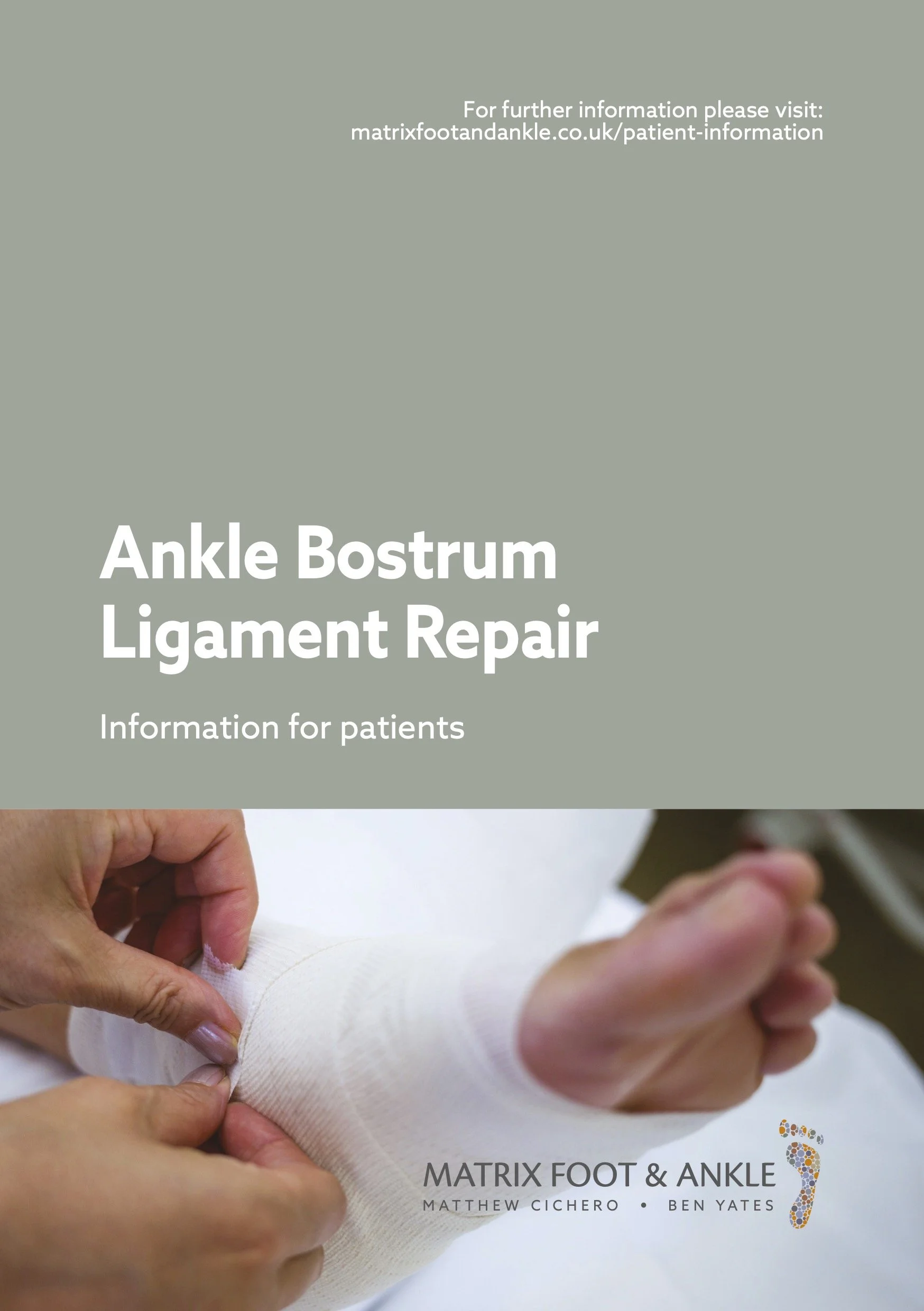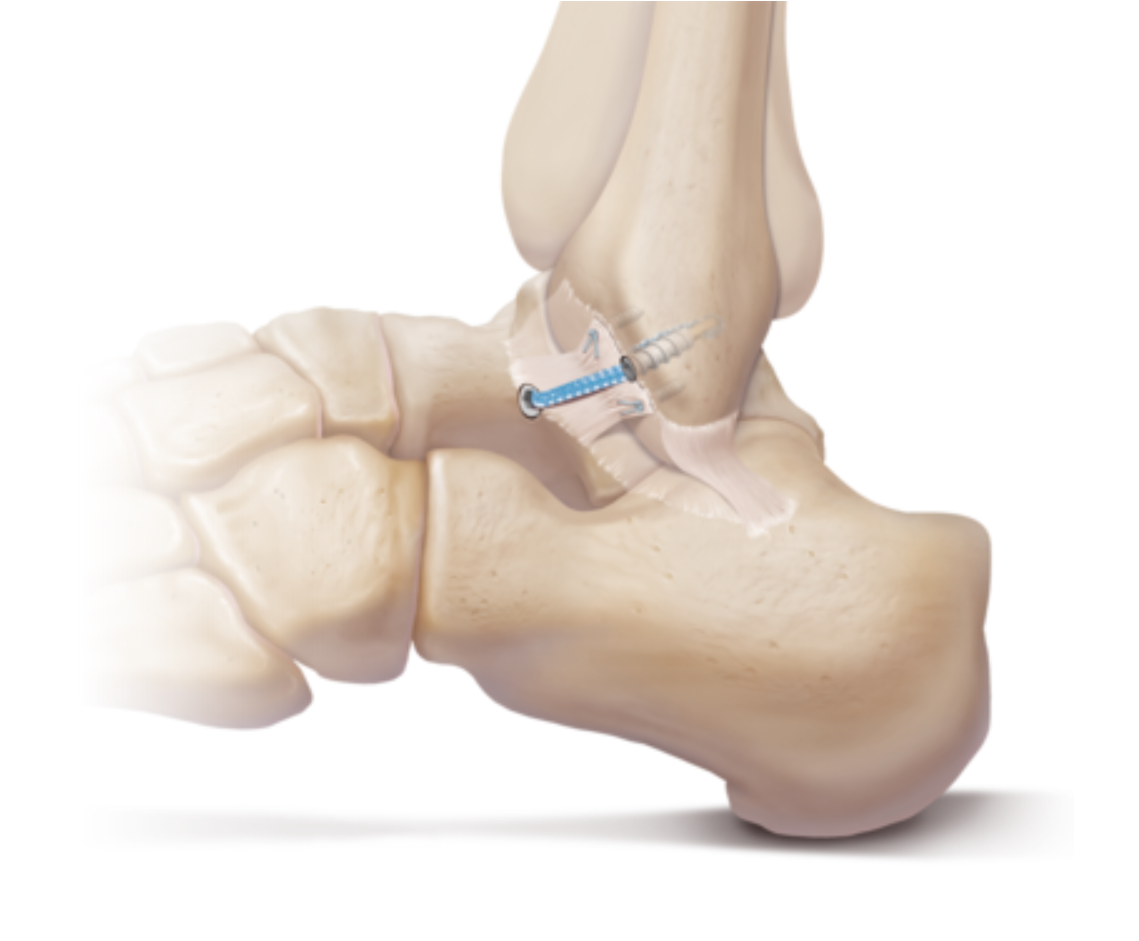Ankle Bostrum Ligament Repair
Procedure
Brostrum ligament repair with internal brace.
Aims of surgery
To reduce pain and instability of the ankle joint. Prevent long-term arthritis to the ankle joint.
Advantages of this operation
Restores and supports the natural ligament.
Reduces risk of the repaired ligament stretching out or re-rupturing.
Faster return to activity.
Do I have to have an operation
Conservative care involves physiotherapy and the use of an ankle brace/support. If this fails then surgery should be considered.
Specific risks of this operation
Nerve damage
Infection (<2%)
Deep Vein Thrombosis/Pulmonary Embolism (<1%)
Problems with ligament anchors
Recurrence of instability (<5%)
Further surgery
Operation time
Usually between 45–60 minutes.
Incision placement/stitches
A cut is made over the outer side of the ankle.
Procedure
The remains of the ligament are found. Small grooves are made in the bone on the outer side of the ankle (the “lateral malleolus”). Small anchors are placed in the bone and stitches attached to these anchors are used to fasten the ligaments back in place. A ligament augmentation rope (internal brace) is then placed over the top of the repaired ligament. The tissues on the outer side of the ankle are then stitched to the ligament to support it. The skin is closed, usually with a dissolving stitch buried under the skin.
Fixation
Internal fixation (bone anchors) are used to repair the ligament. You will not notice these and do not need to be removed.
Will I have plaster?
No. You will be provided with a special boot, which needs to be worn for a minimum of 4 weeks and using crutches to partially weight bear initially.
Is this a Day Procedure?
Yes, you can usually go home the same day (you will usually be admitted for half a day).
Estimated time off work
Non-manual work approximately 1–6 weeks depending on type of work and ability to work from home.
Indications for the procedure
Chronic ankle inversion sprains and pain.
More information
Speak with your consultant.
General risks of surgery
The general risks of foot surgery are outlined in the Pre-operative Information Leaflet which is provided in addition to this leaflet. You should read this leaflet in conjunction with the preoperative information booklet.
Post-Operative Care
First 2 days after surgery
This is the time you are likely to have the most pain, but you will be given painkillers to help. You must rest completely for 2 days. Please try to keep your foot at heart level when resting.
You should restrict your walking to going to the bathroom. When getting about, use your crutches in the way you will have been shown.
Day 3-14
You can get about a little more (often up to 15 minutes/hour).
You will need to attend an appointment for your foot to be checked and redressed usually around 2 weeks.
You may start to do a little more within pain limits. Pain and swelling means you are doing too much.
2-4 weeks after surgery
You may need to attend again. Sutures will be removed if necessary.
The boot is usually removed to start gentle rehabilitation, but is still worn for walking.
At 4 weeks after surgery you will need to attend for a review.
Some swelling to the foot is quite normal at this stage.
You may return to work but may need longer if you have an active job.
You may return to driving when you feel able to be in full control of the vehicle.
4–12 weeks after surgery
The foot should continue to improve and begin to feel normal again.
There will be less swelling.
You will have post-operative physiotherapy to help with your rehabilitation
Sport can be considered after 2–3 months depending on your recovery.
6 months after surgery
You will have a final review between 3–6 months following surgery.
The swelling should now be slight and you should be getting the full benefit of surgery.
12 months after surgery
The foot has stopped improving with all healing complete.
Please note, if a complication arises, recovery may be delayed.
Please note, if a complication arises, recovery may be delayed.


